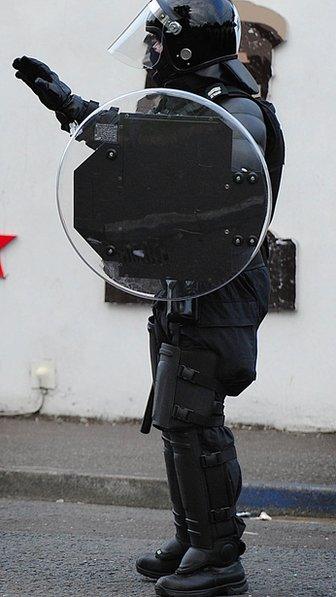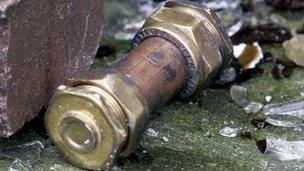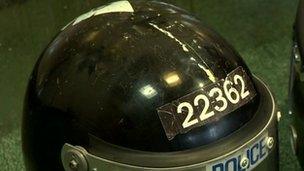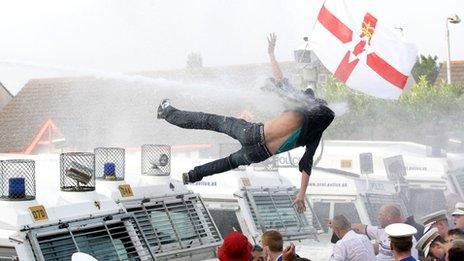How Northern Ireland police deal with lethal riot weapons
- Published

An officer on riot duty is wearing 56lb (25kg) of protective clothing
Colours have huge significance in Northern Ireland, with green indicating Catholic, nationalist or republican, and orange indicating Protestant, unionist or loyalist.
For police officers going on duty, green and blue are the colours that count.
Going to work in "greens" means normal police uniform, but being told to report in "blues" is a very different matter.
Blue is the colour of their public order suits, known to everyone else as riot gear.
"When I got the text saying 'wear blues' I knew I was being deployed to an area where trouble was possible," says one officer who was on duty in north Belfast this week.
When the instruction comes through, officers first put on a layer of flame-retardant cotton clothing from neck to feet, then blue overalls and then heavy duty plastic padding, covering every exposed area, and then military-style boots.
They are then told to wear soft or hard hats.
An instruction to wear baseball caps indicates that while police commanders are prepared for trouble, they are adopting a "softer" approach in order not to antagonise or escalate a situation, and in the hope their worst fears will not be realised.
The next level is the donning of a flame-retardant balaclava to cover the head and face, apart from eyes, mouth and nose, and then a hard helmet, complete with visor.
When fully suited up, each officer is wearing four stones (25kg, 56lb) of protective clothing.
BBC Newsline's Eunan McConville visits the Police Service of Northern Ireland's training centre to find out how officers prepare for public order deployment.
Sinister
On top of that, they wear a belt with gun and radio, and have to carry a heavy-duty riot shield.
They need it all.
Rioters in Northern Ireland, republican and loyalist, often make concerted attempts to seriously injure or kill police officers.
Over the years, weapons used to attack members of the PSNI, and its predecessor the RUC, have ranged from bricks and bottles to ball bearings fired from catapults, golf balls, concrete slabs, iron bars, knives, spears, ceremonial swords, fireworks and petrol bombs.
At the more sinister level, they have also been attacked with a range of homemade bombs, referred to by the police as hand-held improvised explosive devices (IEDs).

Explosives packed into piping and thrown at police
These include:
Blast bombs - crude devices packed into items like tin cans and detonated by a fuse that is lit shortly before being thrown.
Pipe bombs - similar to blast bombs but packed into bits of piping and also detonated by a fuse.
Nail bombs - the above devices, or fireworks, that have nails and shrapnel wrapped around.
In spite of the protective gear, these can have devastating effects.
In September 1998, a 30-year-old RUC officer, and Catholic father of three, Frankie O'Reilly, was on duty in Portadown, County Armagh during riots by loyalists supporting the Orange Order's protest at its annual parade being banned from returning along the Garvaghy Road, which runs alongside a Catholic area.
A pipe bomb landed in front of him and shattered his shield and visor. He lost an eye, suffered horrific injuries, and died four weeks later.
The most severe threat is from gunfire and the PSNI deploys specialist firearms units, equipped with ballistic helmets and shields, with their public order teams.

A police helmet that was damaged by a ceremonial sword
They are not just used to respond to gunfire, they can also be deployed to tackle any other threat to life, like homemade bombs, and swords.
In many countries across the world, police forces would respond to such attacks with live rounds.
The commission headed by Lord Patten, which recommended fundamental reforms of policing in Northern Ireland, including the replacement of the RUC with the PSNI, referred to this in its report in 1999.
"In the United States, the police departments we visited told us that they would regard petrol bombers as a lethal threat and would use live fire against them," it said.
"A Dutch chief constable also told us that, faced with an attack of petrol bombs or blast bombs, his officers would have no alternative but to use live rounds."
'Less lethal'
While the use of live rounds is not part of the PSNI's tactical response to riot situations, the armoury it has available for dealing with public disorder is very different to other UK police forces.
They regularly use plastic baton rounds, referred to locally as plastic bullets. While described as a non-lethal option, their use is highly controversial as plastic bullets and their predecessors, rubber bullets, have resulted in a number of deaths, including those of several children.
Plastic bullets have been used in other parts of the UK as a "less lethal" alternative in firearms situations, but not to deal with public disorder. However, that could change as the Metropolitan Police discussed their possible deployment after the London riots in 2011.

Water cannon can fire jets at a range of speeds
The PSNI is also the only UK police force to use water cannon to disperse rioters.
These fire jets of water at various speeds, depending on the seriousness of the threat. At the lowest setting, rioters are simply soaked, while at the highest, people and objects like large industrial bins can be blown off the ground.
Threat level
Prime Minister David Cameron authorised the use of the PSNI's six water cannons during the London riots, but they were not deployed.
In May this year, the Met asked the government for funding to buy three of the vehicles, but approval has not yet been granted.
The PSNI also uses armoured Land Rovers, which can withstand gunfire and attack by hand-held homemade explosives.
For the first time this year, what are referred to as mutual aid officers from other police forces in England, Scotland and Wales, have been deployed to assist the PSNI.
More than 3,500 were deployed as part of the security operation surrounding the G8 summit in County Fermanagh in June, and this month more than 1,000 have returned as part of the operation to tackle the public disorder that followed an Orange Order parade being banned from walking along a stretch of road in north Belfast.
All the mutual aid officers deployed have undergone special training to acquaint themselves with PSNI tactics, and the different level of threat they face.
"Our mutual aid colleagues have done a tremendous job, but many have been surprised by what they have seen," says one senior PSNI source.
"The threat level is very different to what they have faced before. In the rest of the UK, rioters tend to run away from police lines and avoid confrontation, while here they actively target police. It is a very different dynamic.
"Our tactics are also very different. They are used to working on foot, sometimes with the use of horses, but not with Land Rovers and water cannon, which can be extremely dangerous in confined situations, so they have received specialist training to demonstrate how we use those vehicles as part of our response."